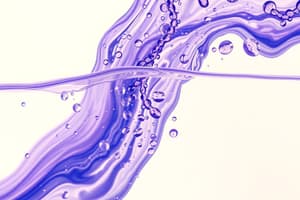Podcast
Questions and Answers
What is the primary function of hydrostatic pressure in capillaries?
What is the primary function of hydrostatic pressure in capillaries?
- To absorb fluids from the interstitium
- To maintain osmotic pressure balance
- To increase fluid retention in the circulatory system
- To force fluids out of capillaries to the interstitium (correct)
What primarily generates osmotic pressure?
What primarily generates osmotic pressure?
- The volume of blood in the circulatory system
- The movement of fluids across cell membranes
- The pressure exerted by the heart
- The concentration of large proteins in the blood (correct)
What is the net result of the pressure gradients in capillaries?
What is the net result of the pressure gradients in capillaries?
- Fluid flows evenly between capillaries and interstitium
- Fluid flows out of capillaries into the interstitium (correct)
- Fluid flows predominantly into the interstitium
- Hydrostatic pressure is equal to osmotic pressure
Which condition can lead to increased capillary hydrostatic pressure?
Which condition can lead to increased capillary hydrostatic pressure?
What could be a consequence of increased capillary permeability?
What could be a consequence of increased capillary permeability?
What is one primary function of lymphatic vessels in the circulatory system?
What is one primary function of lymphatic vessels in the circulatory system?
Which factor could potentially disrupt normal fluid exchange?
Which factor could potentially disrupt normal fluid exchange?
What happens to fluids that do not re-enter the capillaries after filtration out?
What happens to fluids that do not re-enter the capillaries after filtration out?
Match the following terms with their definitions:
Match the following terms with their definitions:
Match the condition with its description:
Match the condition with its description:
Match the following factors with their effects on fluid exchange:
Match the following factors with their effects on fluid exchange:
Match the phenomena with their resulting consequences:
Match the phenomena with their resulting consequences:
Match the following types of obstruction with their sources:
Match the following types of obstruction with their sources:
Match the fluid movement principles with their descriptions:
Match the fluid movement principles with their descriptions:
Match the component with its circulatory role:
Match the component with its circulatory role:
Match the circulation-related terms with their consequences:
Match the circulation-related terms with their consequences:
Hydrostatic pressure in arteries is less than that in veins.
Hydrostatic pressure in arteries is less than that in veins.
Osmotic pressure helps to pull fluid out of the interstitium into the capillaries.
Osmotic pressure helps to pull fluid out of the interstitium into the capillaries.
Increased capillary permeability can lead to excessive fluid retention in the interstitial space.
Increased capillary permeability can lead to excessive fluid retention in the interstitial space.
90% of the fluid that filters out of capillaries is reabsorbed on the arterial side.
90% of the fluid that filters out of capillaries is reabsorbed on the arterial side.
Osmotic pressure is the only factor affecting fluid exchange across the capillary membrane.
Osmotic pressure is the only factor affecting fluid exchange across the capillary membrane.
Tissue injuries can cause decreased osmotic pressure by increasing protein levels in the interstitial space.
Tissue injuries can cause decreased osmotic pressure by increasing protein levels in the interstitial space.
Obstruction in the lymphatic system can be caused by congenital defects or acquired injuries.
Obstruction in the lymphatic system can be caused by congenital defects or acquired injuries.
Venous insufficiency ulcers are solely caused by increased osmotic pressure.
Venous insufficiency ulcers are solely caused by increased osmotic pressure.
Flashcards
Hydrostatic Pressure
Hydrostatic Pressure
The pressure exerted by a fluid in a closed space.
Osmotic Pressure
Osmotic Pressure
Pressure generated by different concentrations of osmotic substances on either side of a membrane to cause fluid movement.
Net Pressure Gradient
Net Pressure Gradient
The difference between hydrostatic and osmotic pressures determining fluid movement.
Fluid Reabsorption
Fluid Reabsorption
Signup and view all the flashcards
Increased Capillary Permeability
Increased Capillary Permeability
Signup and view all the flashcards
Increased Capillary Hydrostatic Pressure
Increased Capillary Hydrostatic Pressure
Signup and view all the flashcards
Lymphatic System
Lymphatic System
Signup and view all the flashcards
Tissue Injury
Tissue Injury
Signup and view all the flashcards
Fluid Flow Across Membranes
Fluid Flow Across Membranes
Signup and view all the flashcards
Hydrostatic Pressure in Capillaries
Hydrostatic Pressure in Capillaries
Signup and view all the flashcards
Osmotic Pressure in Capillaries
Osmotic Pressure in Capillaries
Signup and view all the flashcards
Lymphatic System Role
Lymphatic System Role
Signup and view all the flashcards
Increased Capillary Permeability Cause
Increased Capillary Permeability Cause
Signup and view all the flashcards
Increased Capillary Hydrostatic Pressure Cause
Increased Capillary Hydrostatic Pressure Cause
Signup and view all the flashcards
Lymphatic Obstruction Cause
Lymphatic Obstruction Cause
Signup and view all the flashcards
Fluid Movement Across Membranes
Fluid Movement Across Membranes
Signup and view all the flashcards
Hydrostatic Pressure: Out of the Capillary
Hydrostatic Pressure: Out of the Capillary
Signup and view all the flashcards
Osmotic Pressure: Into the Capillary
Osmotic Pressure: Into the Capillary
Signup and view all the flashcards
Lymphatic System: Homeostasis Helper
Lymphatic System: Homeostasis Helper
Signup and view all the flashcards
Increased Capillary Permeability: Leaky Capillaries
Increased Capillary Permeability: Leaky Capillaries
Signup and view all the flashcards
Increased Capillary Hydrostatic Pressure: Pressure Build-Up
Increased Capillary Hydrostatic Pressure: Pressure Build-Up
Signup and view all the flashcards
Lymphatic Obstruction: Drainage Blockage
Lymphatic Obstruction: Drainage Blockage
Signup and view all the flashcards
Study Notes
Hydrostatic Pressure
- Fluids in closed spaces exert pressure.
- Fluid flow across semi-permeable membranes always moves from higher to lower pressure.
- Hydrostatic pressure pushes fluid out of capillaries into the interstitial space.
- Hydrostatic pressure is greater in arteries than veins.
Osmotic Pressure
- Generated by different solute concentrations across membranes.
- Fluid moves from low to high solute concentration.
- Blood contains more large proteins than interstitial fluid.
- Osmotic pressure pulls fluid into capillaries from the interstitium.
Net Pressure Gradient
- Hydrostatic pressure is generally greater than osmotic pressure.
- Fluid primarily leaves capillaries at the arterial end.
- Approximately 90% of filtered fluid is reabsorbed at the venous end.
- Remaining 10% and all proteins/debris are removed by lymphatic vessels.
Factors Disrupting Fluid Exchange
Increased Capillary Permeability
- Extreme temperature changes.
- Inflammatory responses.
Increased Capillary Hydrostatic Pressure
- Systemic conditions, like Congestive Heart Failure (CHF) and renal failure.
- Pressure on veins (e.g., fetus, tight clothing).
- Blood pooling in lower extremities (e.g., incompetent valves, paralysis).
- Can lead to venous insufficiency ulcers.
- Exercise temporarily increases arterial flow.
Tissue Injury
- Burns cause increased interstitial proteins, decreasing osmotic pressure.
Obstruction in Lymphatic System
- Congenital lack of lymph drainage (primary).
- Acquired injuries, infections, tumors, radiation, or valve changes (secondary).
Studying That Suits You
Use AI to generate personalized quizzes and flashcards to suit your learning preferences.




